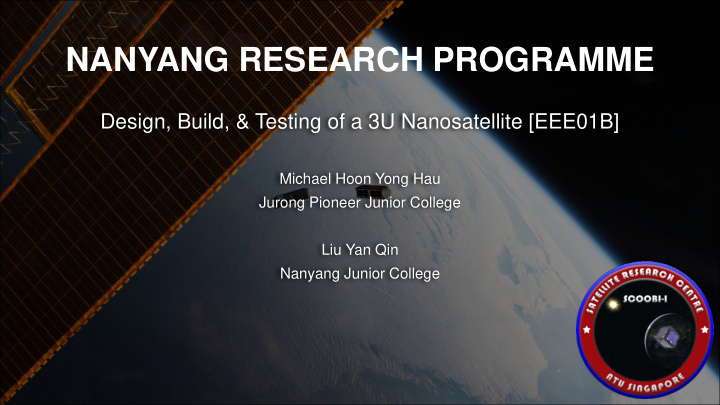



NANYANG RESEARCH PROGRAMME Design, Build, & Testing of a 3U Nanosatellite [EEE01B] Michael Hoon Yong Hau Jurong Pioneer Junior College Liu Yan Qin Nanyang Junior College
Dimensions of a CubeSat • Standard 1U CubeSat - 10 × 10 × 10cm - Mass of 1.33 kg - Radiation Hardened Aluminium Chassis
Reasons for CubeSat Development • Introductory teaching tool for students to learn about space hardware • Reduce cost and development time, which provides increased access to space hardware for universities • Ensures that Singapore remains competitive and relevant in the space industry, especially due to its small size
Subsystems • Communication with the ground station [COMM] • On-Board Data Handling and Storage [OBDH] • Attitude Determination and Control System [ADCS] • Electrical Power System [EPS] • Mechanical Structure and Thermal Control System • Payload
Main Focus of Project 1. Electrical Interfacing of the different components in a standard 3U CubeSat 2. Determining the most efficient variation of the electrical interface that would best suit our selected parts 3. Create a functional block diagram depicting the numerous electrical interfaces present
Mission Objective of SCOOBI • Two spectrometers will measure solar irradiance in the visible and NIR bands of the E-M spectrum • Data collected will be used to corroborate data for models proposed by NASA • Imager to capture images in LEO • IoT device • More payloads will be added in the future
Theory review • Research on different types of electrical interfaces • I2C • SPI • UART/USART • CAN • Determine Advantages/Disadvantages and allocate accordingly
UART • Universal Asynchronous Receiver Transmitter • Hardware device for serial communication between computer subsystems • Usually part of an Integrated Circuit (IC) • Advantages • 2 lines, no clock signal • Disadvantages • Only 1 master and slave, • Baud rates must be similar between devices for UART to work
I²C • Inter-Integrated Circuit • Fast communication between master and slave units • Advantages • Only 2 wires • Able to support multiple masters and slaves • Disadvantages • More complex wiring and programming • Slower data transfer rates than SPI but higher than UART
SPI • Serial Peripheral Interface • High speed communication interface typically used for short- distance communication within a system • Advantages: • High speed, lower power usage, allows for simultaneous flow of data • Disadvantages • Uses 4 wires and more pins • Only handles short distances
CAN • Controller Area Network • An interface designed to allow subsystems to communicate with each other without the need for complex wiring • Advantages • More resistant against EM interference • Less wiring • Disadvantages • More development costs for software development and maintenance
Literature Review • Case study on DIP report done by undergraduates • Proposed a design of a 2U CubeSat, which utilized I²C protocol between every component • Programmed using an Arduino UNO microcontroller as the OBC Key Takeaways: 1. Using I²C as the main communication protocol may be convenient, but does not reap the most efficient results 2. Extensive research must be conducted on the electrical interface for an actual CubeSat, and must not be neglected.
Methodology • Design and proposal of the electrical interface was based on the selected parts of the CubeSat • Parts were selected based on a multitude of factors such as cost and weight, apart from the communication protocols which they support • Communication Protocols were allocated to best suit the parts, such as high baud rate requirements or synchronous communication
On-Board Computer in C&DH • Based on the ARM Cortex M4 Processor, clock speed of 180MHz • Highly versatile as multiple customizable interfaces are available • 1 CAN Bus interface, 2 USART and 1 UART, 2 SPI, 2 I²C, 1 USB for connections with a PC EnduroSat OBC Module
ADCS Module - Magnetorquer • The OBC includes integrated ADCS sensors for magnetorquer control and orientation data collection • Two 3- axis digital compasses for measuring Earth’s magnetic fields, accelerometers to measure acceleration • The main orientation device for SCOOBI is a permanent magnet which aligns itself with Earth’s magnetic field.
COMM Module – Transceiver + Antenna Acts as a two-way radio system • Able to transmit and receive data to and • from the ground station Operates in the UHF band ~430-440MHz • EnduroSat UHF Transceiver will utilise UART, while Antenna Transceiver • uses I²C for deployment controls Chosen based on native support of • interfaces Antenna Module
Table of Comparison - COMM
EPS Module • Chosen to reduce compatibility issues with the OBC • Supports up to two Li-Po batteries of 10.4Wh each • Supports UART, I²C and USB • The UART interface will be used as synchronous EnduroSat EPS Module communication and high baud rates are not required
Table of Comparison - EPS
Payload • Two spectrometers measuring solar irradiance in the Near-Infrared and Visible bands of the E-M Spectrum • Corroborate aviation models proposed by NASA • Provides real-time tracking of the amount of radiation received by flight personnel on a flight SparkFun Spectrometer Device • Interface used will be UART and I²C as high baud rates are required to transfer data
Final Functional Block Diagram of SCOOBI
Future Direction • Expected to be launched by ISRO in November 2020 • Future students working on CubeSat missions should not neglect the importance of defining electrical interfaces
Recommend
More recommend